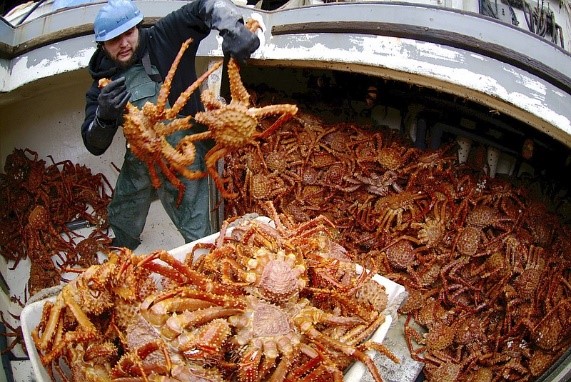PART 1
Since 1975, the surveilling authorities of Alaska fisheries tallied snow crabs in the billions. It was observed and confirmed over the years that animal populations rarely remain steady, owing to poor survey procedures, over-harvesting, a movement of life based upon changes to the environment, and simply poor management of a resource. About ten years ago, scientists, declared that they had “found the largest number of juvenile snow crabs ever”. That was important because the juveniles produced the next generation of crabs.
However, in 2021 they found “the fewest juvenile snow crabs” since population surveys began being recorded on crab species 46 years ago. That result forced the closure of the snow crab season, which is one of the most important ones in Alaska’s economy and for the world’s crab lovers. The first question was what happened to create that mystery?
The simplest explanation seemed to be that “10 billion crabs disappeared” due to overcatches, disease, depletion by predators, or huge movement of the population to more beneficial environments for one reason or another. Fisheries records from 1975 to 2021 revealed only minimal changes year to year in the total number of crabs taken by commercial fishing. It was determined that the Pacific cod was not responsible as their numbers declined as they moved more northerly than the crabs would venture.
If warmer water—which was found then and persists to the present day–is the key cause, then all of those crabs might somehow moved to colder water somewhere in the Bering Sea. The investigators studied the entire Alaska arctic and subarctic region and further south without finding any appreciably increased numbers of crabs anywhere else. The disease did not seem feasible because nothing had been identified on the surviving crabs surveyed. Disease that could kill 10 billion crabs from the biomass would have been visible even in just those examined for the survey. Furthermore, a disease that could kill 10 billion crabs from the biomass would have been clearly visible even in just those examined for the survey.
Was it a massive and repeated scientific laboratory mistake? Scientists and laboratory technicians are humans, after all, and sometimes mistakes are made in methodology or the procedure itself. There is an example that is to the point. About 50 years ago a large herd of caribou was mistakenly counted twice by a flyover census of the Alaskan tundra which is done by giving the best guess, and that is not very accurate to begin with. The double count occurred because of an error about how far and how fast caribou migrate. In that instance the mistake happened because the herd was seen by another Fish & Game scientist—a man with long experience—who knew there was no way that the same herd could have moved that far or that fast; so, they were counted again and added to the total official population of caribou which determined the number that could be hunted by state regulation.
In that instance, the mistake was not particularly important because of the huge numbers—in the millions—present on the tundra. The mistake resulted in a few more caribou being harvested but did not affect the overall reproductive capacity of the vast herd. Even if the hunting tags–including the mistaken ones, had been filled, a rare possibility, indeed–it would still not make a dent in the species population. For a large herd, even double the number of tags given out and filled would not be likely to exceed the real number that should be taken to keep the herd healthy. In fact, the herds were over-hunted and harvested to a degree; so, for the next several years caribou tags were somewhat easier to obtain than usual, and a few more caribou went into meat lockers. It was several years before the population returned to what was considered to be normal, but the final result was negligible. The only indisputable fact in that situation is that no one knows exactly what happened. At one point, investigators of the great crab loss arrived at the same conclusion.
The dogged investigators kept on. The next hypothesis considered as a possibility was that “their food disappeared” causing widespread starvation. That idea was supported by the most reliable evidence collected at that point. But why? That was the germ of a viable explanation.
Water temperature change did occur and persists to the present day, as does the overkill of the young snow crab. So, the blame was placed on the water temperature, i.e. being too warm. At that point, the investigators began asking, “Could any or a combination of several or all of these factors together have caused the “loss” of population? There was still the nagging question suggesting that maybe we have no idea where 10 billion snow crabs have gone every year. That is disappointing; there will be no simple answer found because this is a complex phenomenon, and we will likely have to learn about multiple underlying causes as time goes on.Along those lines are several clearly known pieces of pertinent information: this is a “sudden” problem. At least some of its roots go back three or four years while others go back one or two decades as the most reliable evidence indicates. The fishery has mostly been in decline since 1996 and almost completely in decline since 2009.
In 2019 the region suffered a period of warming waters, which snow crabs cannot tolerate. The year before, fisheries surveys noted large numbers of juveniles in the region and managers interpreted that to mean strong catches in the years to come. Fishermen have been reporting that this species has been demonstrably overfished for at least three decades. Unfortunately, the reported 2018 surge in juvenile crabs allowed managers to bet in setting harvest numbers. In the clarity of hindsight, it appears that they should have been more conservative.
Even the 2019 warming episode should have set off alarms about a possible crash; but it failed to do so at least to any serious degree, say conservationists and some fishermen. It should also serve as a harbinger of things to come as ocean warming—which is a real and provable environmental phenomenon—is becoming more and more of an issue.
Everyone agrees that an overwhelming number of crabs is missing from the typically frigid, treacherous waters of the Bering Sea. In 2022, it was more of a resignation that this is going to be a long road with no clear solution in sight. That year was the first the US snow crab fishery was closed in Alaska. Even though crab catchers attributed the population decline to overfishing, but that is a technical definition does not explain the collapse.
The manager of the Alaska State Fisheries says, “…is that historically, fishery scientists had been very worried about overfishing; and this has been our white whale, and in a lot of places we really solved that with management, but climate change is throwing a wrench into our plans, our models and our management systems.”
Snow crabs are native to the Northwest Atlantic and the North Pacific. In the Northwest Atlantic, they are found in the areas near Greenland, Newfoundland, in the Gulf of St. Lawrence, and on the Scotian Shelf. In the North Pacific, this crab is found in areas ranging from Alaska to northern Siberia, and through the Bering Strait to the Aleutian Islands, Japan, and Korea.
In 1996, they were recorded in the Barents Sea for the first time. They are considered an invasive species there, and how they arrived there is unclear, but it is important. Another commercially important species, introduced deliberately to the same region, the red king crab, has already established itself in the Barents Sea. Likely, snow crabs will probably hurt the native species of the Barents Sea, because they are exotics. They require a degree of management, which until 1976 was afforded by commercial fishing.
Chionoecetes opilio [Snow crabs] are found in the ocean’s shelf and upper slope–on sandy and muddy bottoms—where they are found at depths from 43 to 7,175 feet. In Atlantic waters, most snow crabs are found at deeper depths. Large and hardy adult males are found mostly at depths greater than 260 feet. Adult females are gregarious and congregate at depths of 200–390 feet. Snow crabs mainly reside in very cold waters, between 30-41 °F, and often in even colder waters. Almost all crabs eat other invertebrates in the benthic shelf, such as crustaceans, bivalves, brittle stars, polychaetes, phytobenthos, and foraminiferans. Snow crabs are scavengers, and the also prey on annelid worms and mollusks. Cannibalism is practiced at times among snow crabs, most frequently by intermediate-sized females.
Snow crabs grow slowly with ~11 stages of growth for male crabs being recognized. Male crabs are almost twice the size of the female crabs. Males caught in commercial fisheries generally weigh ~1.1–3.0 pounds. Snow crabs have very high reproductive potential; each year, every female carries eggs that are fertilized internally and can carry up to 150,000 eggs under their abdomens after mating. Females usually lay their eggs in very deep areas of the ocean, often in deposits of phytodetritus. Snow crabs have an average lifespan of 14–16 years. New snow crab offspring hatch along with the late spring phytoplankton bloom, so they have an ample food source to take advantage of upon hatching. Snow crab was commonly caught by trappers in the 1980s, but trapping has decreased since then. The first commercial fishing for the species in the Barents Sea began in 2013, and the stock of this region likely will reach levels similar to eastern Canada in the future.
In 2022, the ADF&G [Alaska Department of Fish and Game] banned commercial fishing of snow crabs in the Bering Sea for the first time for the 2022/23 season. The population shrank from ~ eight billion in 2018 to one billion in 2021. The causes are overfishing as well as increased water temperatures as a result of climate change.


